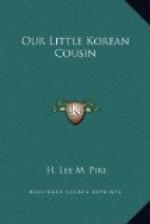The house was but a single story high, but in this respect the king’s palace itself was no better. There were three divisions to the house. One was for the use of the men, a second for the women of the family, and a third for the servants. Each division had a suitable number of rooms for its occupants.
Yung Pak’s own sleeping-room was a dainty affair, with its paper walls, tiger-skin rugs upon the stone floor, and the softest of mats and silk and wadded cotton coverings for his couch.
This couch, by the way, was another queer affair. It was built of brick! Beneath it were pipes or flues connected with other pipes which ran beneath the whole house. Through these flues were forced currents of hot air from a blaze in a large fireplace at one end of the house. The chimney was at the other end, and thus a draught of hot air constantly passed beneath the floors in cold weather. On warm nights Yung Pak would pile his mats upon the floor and sleep as comfortably as ever you did on the softest feather bed your grandmother could make.
The windows of Ki Pak’s house were not made of glass, but were small square frames covered with oiled paper. These frames fitted into grooves so that they could be slid back and forth, and in warm weather the windows were always left open. The doors were made of wood, though in many houses paper or plaited bamboo was used.
When Yung Pak ate his meals, he sat upon a rug on the floor with his father and such male guests as might be in the house. The women never ate with them. Their meals were served in their own rooms.
A servant would bring to each person a sang, or small low table. Instead of a cloth, on each table was a sheet of fine glazed paper which had the appearance of oiled silk. This paper was made from the bark of the mulberry-tree. It was soft and pliable, and of such a texture that it could be washed easier than anything else, either paper or cloth. On this were placed dishes of porcelain and earthen ware. There were no knives or forks, but in their place were chop-sticks such as the Chinese used. Spoons also were on the table. A tall and long-spouted teapot was always the finest piece of ware.
On the dining-tables of the poorer people of Korea the teapot was never seen, for, strange as it may seem, in this land situated between the two greatest tea-producing countries of the world, tea is not in common use.
All Koreans have splendid appetites, and probably if you should see Yung Pak eating his dinner you would criticize his table manners. He not only ate a large amount of food, but ate it very rapidly—almost as if he feared that some one might steal his dinner before he could dispose of it. And you would think that he never expected to get another square meal!
But it was not Yung Pak’s fault that he was such a little glutton. In his youngest days, when his mother used to regulate his food, she would stuff him full of rice. Then she would turn him over on his back and paddle his stomach with a ladle to make sure that he was well filled!




